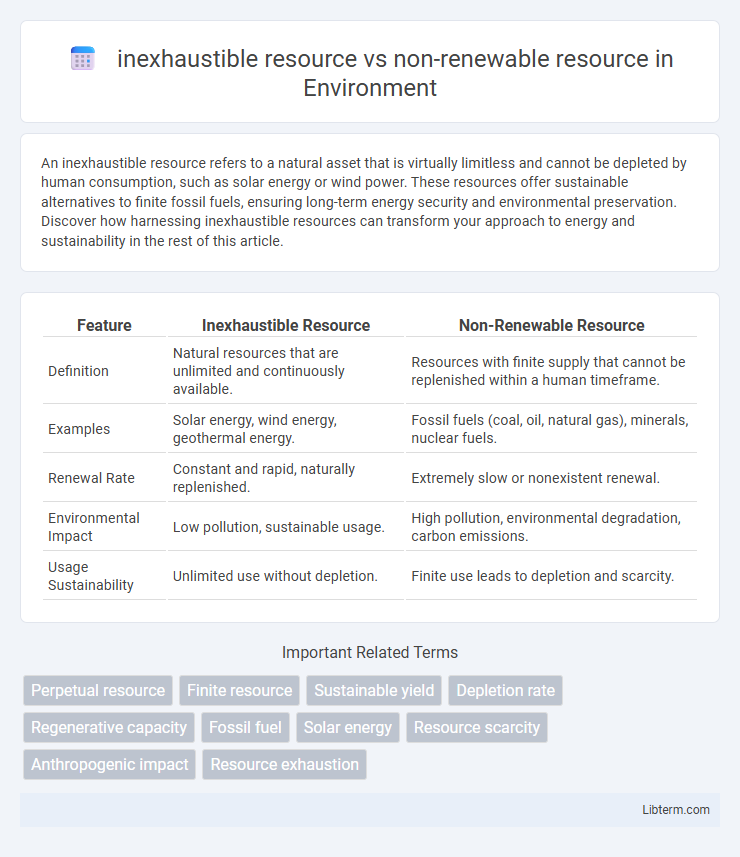An inexhaustible resource refers to a natural asset that is virtually limitless and cannot be depleted by human consumption, such as solar energy or wind power. These resources offer sustainable alternatives to finite fossil fuels, ensuring long-term energy security and environmental preservation. Discover how harnessing inexhaustible resources can transform your approach to energy and sustainability in the rest of this article.
Table of Comparison
| Feature | Inexhaustible Resource | Non-Renewable Resource |
|---|---|---|
| Definition | Natural resources that are unlimited and continuously available. | Resources with finite supply that cannot be replenished within a human timeframe. |
| Examples | Solar energy, wind energy, geothermal energy. | Fossil fuels (coal, oil, natural gas), minerals, nuclear fuels. |
| Renewal Rate | Constant and rapid, naturally replenished. | Extremely slow or nonexistent renewal. |
| Environmental Impact | Low pollution, sustainable usage. | High pollution, environmental degradation, carbon emissions. |
| Usage Sustainability | Unlimited use without depletion. | Finite use leads to depletion and scarcity. |
Introduction to Resource Types
Inexhaustible resources, such as solar and wind energy, are naturally replenished and virtually limitless, making them essential for sustainable development. Non-renewable resources, including coal, oil, and natural gas, exist in finite quantities and are depleted faster than they can naturally regenerate. Understanding the key differences between these resource types is crucial for managing environmental impact and energy policy.
Defining Inexhaustible Resources
Inexhaustible resources, such as solar energy, wind power, and geothermal energy, are natural assets that are abundant and continuously replenished by natural processes, making them virtually unlimited in supply. These resources contrast sharply with non-renewable resources like coal, oil, and natural gas, which are finite and deplete over time due to consumption faster than their natural formation. Understanding the defining characteristics of inexhaustible resources is crucial for sustainable energy planning and reducing environmental impact.
Understanding Non-renewable Resources
Non-renewable resources, such as coal, oil, and natural gas, are finite energy sources formed over millions of years and cannot be replenished within a human timescale. Understanding non-renewable resources is crucial for managing energy consumption, as their extraction and use lead to environmental degradation and eventual depletion. Unlike inexhaustible resources like solar and wind energy, non-renewables contribute significantly to greenhouse gas emissions and climate change.
Key Differences: Inexhaustible vs Non-renewable
Inexhaustible resources, such as solar and wind energy, are naturally replenished and considered limitless on a human timescale, whereas non-renewable resources like coal, oil, and natural gas are finite and deplete over time due to extraction and consumption. The key difference lies in sustainability; inexhaustible resources provide a continuous supply without risk of exhaustion, while non-renewable resources diminish with use and require significant time to form again, if at all. Understanding this distinction is crucial for energy policy and environmental management to promote long-term resource availability and reduce ecological impact.
Common Examples of Inexhaustible Resources
Solar energy and wind power are prominent examples of inexhaustible resources, harnessed continuously without depletion. Unlike non-renewable resources such as coal, oil, and natural gas, inexhaustible resources rely on naturally recurring processes like sunlight and atmospheric wind patterns. Geothermal energy and tidal power also exemplify inexhaustible resources, contributing to sustainable energy solutions by providing constant, renewable power sources.
Major Types of Non-renewable Resources
Major types of non-renewable resources include fossil fuels such as coal, oil, and natural gas, which are formed from ancient organic matter over millions of years. These resources are finite and deplete quickly due to extensive extraction and consumption. Unlike inexhaustible resources like solar and wind energy, non-renewable resources contribute significantly to environmental pollution and greenhouse gas emissions.
Environmental Impact Comparison
Inexhaustible resources, such as solar and wind energy, produce minimal environmental pollution and have a significantly lower carbon footprint compared to non-renewable resources like coal and oil, which release greenhouse gases contributing to climate change. The extraction and consumption of non-renewable resources lead to habitat destruction, air and water pollution, and long-term ecological damage. Transitioning to inexhaustible resources supports sustainable development by reducing environmental degradation and mitigating global warming impacts.
Sustainability and Future Prospects
Inexhaustible resources, such as solar and wind energy, offer sustainable solutions due to their continuous availability and minimal environmental impact, ensuring long-term energy security and reduced carbon emissions. Non-renewable resources like coal, oil, and natural gas are finite, leading to depletion risks and increased greenhouse gas emissions that exacerbate climate change and hinder sustainability efforts. Transitioning to inexhaustible resources is crucial for sustainable development, fostering resilient energy systems and safeguarding environmental health for future generations.
Economic Implications of Resource Usage
Inexhaustible resources, such as solar and wind energy, offer sustainable economic benefits by providing a continuous supply without depletion, leading to lower long-term costs and energy security. Non-renewable resources, including fossil fuels and minerals, face eventual scarcity, causing price volatility and higher extraction expenses that impact economic stability. Transitioning to inexhaustible resources promotes economic resilience and reduces dependency on finite assets, fostering sustainable growth and investment opportunities.
Strategies for Responsible Resource Management
Implementing advanced technologies such as smart grids and energy storage maximizes the efficiency of inexhaustible resources like solar and wind energy. Enforcing stringent regulations and promoting sustainable extraction practices mitigate the environmental impact associated with non-renewable resources including coal, oil, and natural gas. Investing in education and policy frameworks further supports the transition towards a balanced resource management system that prioritizes long-term ecological health and economic stability.
inexhaustible resource Infographic

 libterm.com
libterm.com